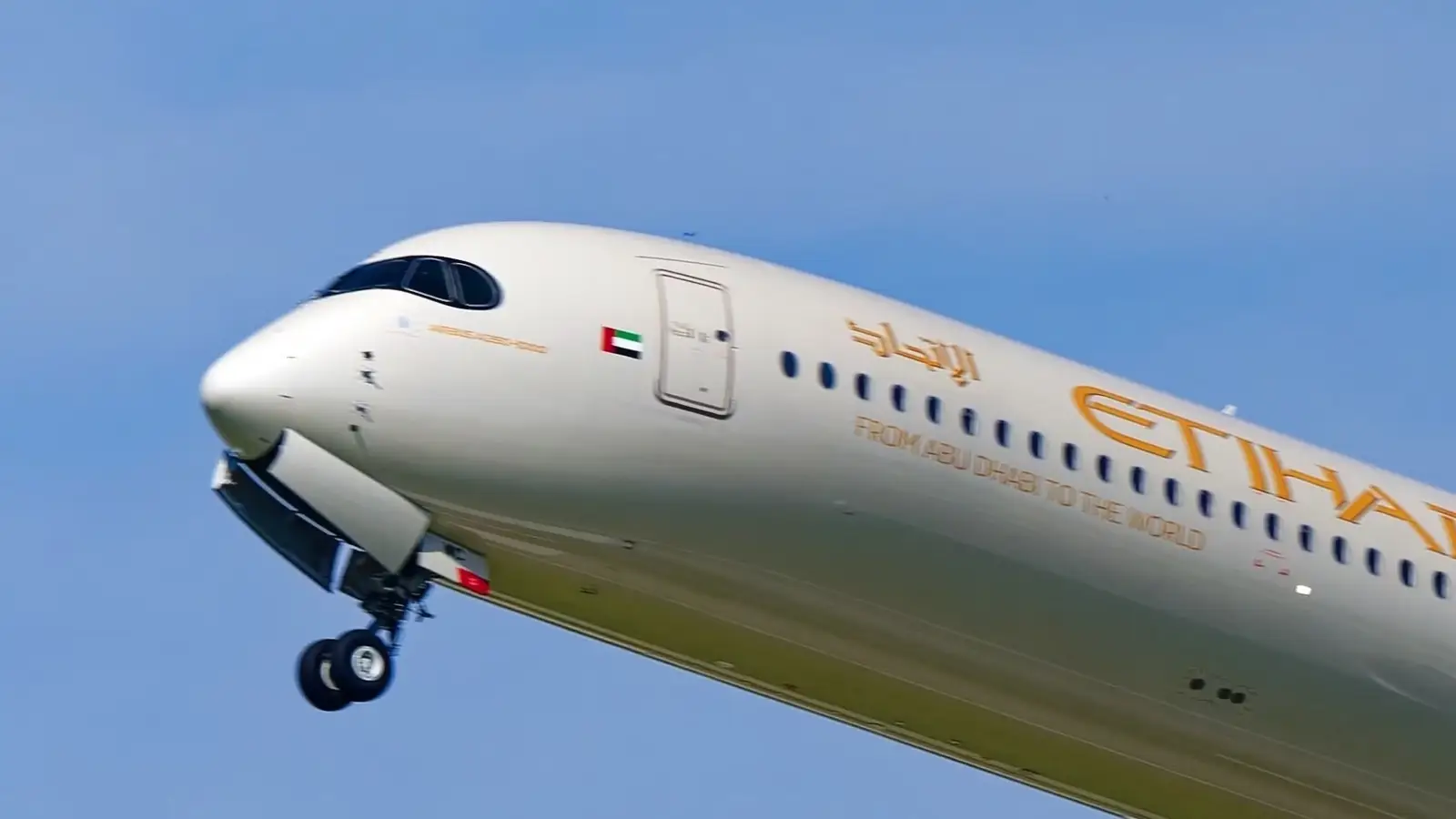
The Airbus A350 is a core element of most global long-haul fleets today. Offering exceptional operating and per-seat economics, the aircraft is capable of providing high-capacity services on long-haul sectors. The jet’s fuel efficiency makes it one of the most capable aircraft in the skies today, and it can cover long-range distances that would previously have required a stopover. Legacy carriers enjoy the aircraft just as much as low-cost carriers, both of which have continued to praise the aircraft’s extensive versatility and ability to offer long-haul connectivity. Very few airlines have passed on the opportunity to add this unique model to their fleet.
Abu Dhabi-based Etihad Airways is no exception to this role. The long-haul carrier has been known to operate flagship services all across the globe using the model. Etihad is historically known for its premium products, especially on board its flagship Airbus A380. However, the A350 still offers an effective platform for the deployment of premium capacity. The aircraft is thus a key element of Etihad’s network, serving high-profile routes all across the globe. We analyze the purpose that the Airbus A350 plays in the Etihad fleet today, with an emphasis on identifying the jet’s longest individual mission deployment.
A Brief Overview Of Etihad Airways And The Airbus A350
Etihad Airways undeniably has a high-profile relationship with the Airbus A350-1000, which has, for years now, been a pillar of the carrier’s post-restructuring long-haul strategy. The airline pruned a massive Airbus A350 order during its 2017-2020 operational and strategic reset, but the carrier ultimately introduced the type in 2022 and positioned the aircraft as a fuel-efficient flagship that would join the Boeing 787. From an operational perspective, the Airbus A350-100 gives Etihad Airways a quiet, long-range, high-comfort platform for operating dense trunk routes.
The aircraft offers lower trip burn and noise statistics in comparison to older widebodies, and the jet is useful for night operations and at slot-constrained airports. From a commercial perspective, the aircraft anchors the airline’s new business class suite cabins, which offer privacy doors. The aircraft is also equipped with upgraded premium economy class cabins, helping it win corporate contracts and improve performance without having to introduce the risk that comes along with an ultra-high-capacity aircraft like the Airbus A380.
From a strategic perspective, the aircraft helps diversify Etihad’s long-haul fleet, pushing beyond the capabilities of the Boeing 787. Engine/supply-chain exposures and gauge flexibility are big enough to help consolidate banks during peak seasons, but economical enough to ensure that shoulder seasons remain profitable. The aircraft is used extensively on long-haul overwater routes, freeing up the Boeing 787 to serve medium-distance sectors. In the future, the airline will continue to deploy the aircraft on routes where continuing to grow demand will be critical and the use of premium cabins remains essential.
What Role Does The Airbus A350 Play In The Etihad Fleet?
Etihad Airways has been known to use the Airbus A350-1000 as its highly-efficient, premium-oriented long-haul workhorse alongside the Boeing 787, with a small, peak-capacity-oriented Airbus A380 fleet. The Airbus A350-1000’s purpose is primarily to offer Etihad high-capacity gauge without the Airbus A380’s trip-level costs. This makes the jet ideal for trunk routes to Europe, North America, and North Asia, all places where airports tend to have slot or noise restrictions (or possibly even both).
The aircraft’s lower fuel burn figures and quieter cabin help lower unit costs and passenger approval, allowing the aircraft to safely and reliably operate night flights out of Abu Dhabi. The aircraft’s door-equipped business-class suite, alongside stronger performance in premium economy cabins, as well as modern in-flight entertainment, has allowed Etihad to help sell a consistent flagship product in the business-class cabins. From a strategic perspective, the aircraft slots nicely between the capacity of the Boeing 787-10 and the Airbus A380.
Using the aircraft on high-capacity sectors frees up Boeing 787-10 jets to operate on medium-haul sectors and other kinds of long-haul missions. This allows the Airbus A380 to be refocused on simply the highest-capacity models. When it comes to the aircraft’s cargo base, the Airbus A350’s belly hold supports e-commerce and pharmaceutical flows without the need for a dedicated freighter to operate on every route.
How Does Etihad Airways Use Its Airbus A350s?
The Etihad Airways Airbus A350-1000 operates services on a handful of high-capacity long-haul routes, in addition to some high-frequency services from South Asia. North America currently dominates the aircraft’s ASM figures, with Chicago O’Hare being one of the A350’s largest destinations, with 352 flights in each direction throughout the year. This equates to more than 950 million available seat miles, a figure that John F. Kennedy International Airport (JFK) trails at 489 million available seat miles.
Ultra-long stages to Sydney Airport (SYD) add another 186 million available seat miles in each direction. These are routes that sit among the longest on the airline’s route network, helping showcase the airline’s long-range premium backbone. Asia helps anchor the airline’s Airbus A350 route network, with daily connectivity to Tokyo Narita Airport (NRT). Some other major Airbus A350 destinations include Brussels (BRU), Zurich (ZRH), and Milan Malpensa (MXP).
In total, the data provided to Simple Flying by airline industry database Cirium Aviation Analytics demonstrates more than 3,700 flights, 1.4 million seats, and 6.8 billion available seat miles on these routes. The airline’s Airbus A350 portfolio is undeniably weighted towards long-haul North America and Asia routes, with some European services slowly mixed in.
What Is Etihad’s Longest Airbus A350 Route?
The longest individual route that Etihad operates with the Airbus A350-1000 is its nonstop service from Abu Dhabi International Airport (AUH) to Hartsfield-Jackson Atlanta International Airport (ATL). This route covers more than 7,600 miles, and it demands a jet that meets the A350’s specifications to profitably serve this ultra-long-haul connection.
Our data demonstrates more than 130 flights in each direction, 49,000 seats, and roughly 373 million available seat miles in each direction. This is a large amount of capacity for any single city pair, especially for a secondary destination like Atlanta. From a strategic perspective, the airport is an excellent hub, helping broaden Eithad’s exposure to the North American and, by extension, Latin American markets as well.
The aircraft’s belly cargo economics also fully support long-haul operations, especially between major business travel hubs where cargo demand also runs strong. This is ultimately the best combination of factors for any route served by the Airbus A350-1000.
What Other Carriers Operate Large Airbus A350 Fleets?
The Airbus A350 is in service with airlines from all across the globe today. There are two principal variants of the model, the Airbus A350-900 and the Airbus A350-1000, each of which caters to its own kind of customer. In Europe, the biggest customers are British Airways, Air France, Lufthansa, Iberia, Finnair, SAS, Virgin Atlantic, Turkish Airlines, ITA Airways, French Bee, and Air Caraibes. All these carriers see the model as an integral part of their long-haul networks, expanding premium capacity and supporting global connectivity.
In the Asia-Pacific region, Singapore Airlines, Cathay Pacific, Japan Airlines, China Airlines, and Vietnam Airlines are all major operators of intercontinental widebody aircraft. Thai Airways, Malaysia Airlines, Asiana, and Ethiopian are also big players in the greater Asia-Africa region, with some mainland Chinese carriers also extensively operating the model as well. The aircraft simply offers too appealing a benefits and efficiency package for most operators to overlook.
In the Middle East, Qatar Airways, Etihad Airways, and Emirates are all the biggest players. In the United States, Delta Air Lines remains a major operator of the Airbus A350-900, with Latin American carrier LATAM also previously operating some models. Some small-market players include Air Mauritius and Philippine Airlines, both of which use the aircraft to serve their unique challenges.
So, What Is Our Principal Takeaway?
At the end of the day, there are a few different ways in which we could potentially analyze the role that the A350-1000 currently plays in the Etihad Airways fleet. In our eyes, the model offers exceptional long-range capabilities while providing unbeatable per-seat economics.
These are the principal reasons behind the fact that the model has achieved such impressive commercial success over the past decade. Beyond this, the model is also a key piece of the Etihad Airways expansion picture, which identifies this aircraft as a key piece of how the airline plans on being able to dig into other markets.
The airline clearly has its sights set on expansion, and some ultra-long-haul journeys (such as those to cities like Chicago and Atlanta) would be fundamentally infeasible without the aircraft type. We will simply have to see what the future holds for this impressive aircraft variant, which has already proven itself in terms of safety, reliability, and efficiency.



